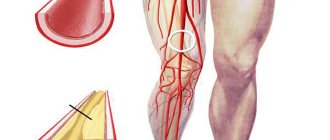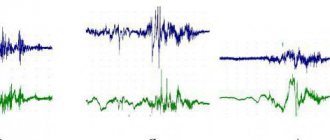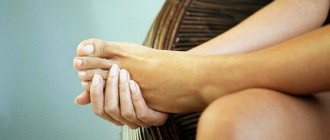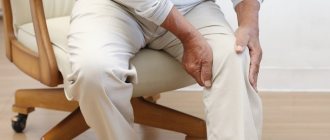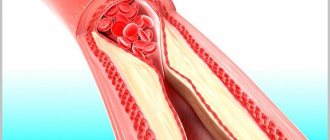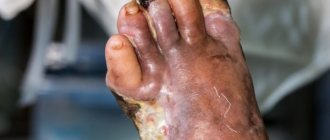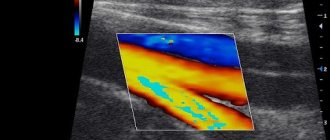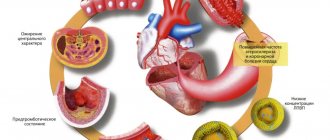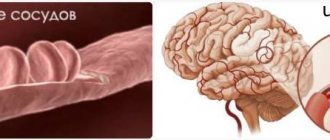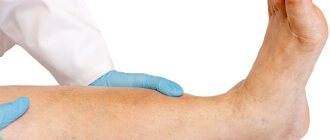In this article, you will learn how to improve blood circulation in your legs through lifestyle changes, medications, and surgery.
Poor circulation in the legs is a symptom of various diseases that lead to narrowing of arterial vessels or stagnation of blood in the veins. These diseases include diabetes mellitus, atherosclerosis, obliterating endarteritis, thrombophlebitis, and varicose veins.
Deterioration of blood circulation in the legs can be detected by the presence of symptoms, which depend on the type of disease. Arterial blood flow disorders are manifested by pain in the legs when walking, numbness and weakness in the lower extremities, changes in skin color and hair loss, a constant feeling of coldness in the legs, brittleness and slow growth of nails, and decreased muscles in the legs. Venous congestion is manifested by blue skin color, swelling in the legs, the presence of varicose veins, trophic changes and ulcers on the lower extremities.
If these symptoms are present, the doctor examines the patient, determines pulsation in the arteries of the legs, and identifies signs of venous stagnation.
To clarify the diagnosis, doctors use instrumental examination methods, including:
- The ankle-brachial blood pressure index is the simplest and most accessible method for assessing the deterioration of blood flow in the legs. With the patient lying down, the doctor or nurse measures the pressure in the shoulder and ankle. The score obtained at the ankle is then divided by the score obtained at the shoulder. Normally, the level of blood pressure in the arms and legs is almost the same, so the index is approximately equal to 1. However, if arterial blood flow in the legs is impaired, the pressure at the ankle decreases, so the index becomes lower than 1.
- Ultrasound examination of the vessels of the lower extremities allows you to evaluate blood flow in the arteries and veins, detect their narrowing and thrombosis. An indispensable method for diagnosing vascular diseases of the lower extremities.
- Angiography is an X-ray examination of blood vessels using a contrast agent injected into them.
Methods for diagnosing poor circulation in the legs
Most diseases that impair blood supply to the legs are chronic, so they can rarely be completely eliminated. Sometimes improving the condition or stopping the progression of the disease is the best result of treatment, which is based on lifestyle changes, the use of medications and surgical interventions. Sometimes, with arterial insufficiency, the blood flow in the legs is so poor that amputation must be done.
Vascular surgeons deal with the problem of poor circulation in the legs.
Improving blood circulation in your legs with lifestyle changes
In the initial stages of deterioration of blood flow in the legs, you can prevent the progression of the disease and alleviate its symptoms through lifestyle changes:
- To give up smoking.
- Avoiding alcohol abuse.
- Healthy eating.
- Physical activity.
- Normalization of weight.
- Other recommendations.
To give up smoking
Quitting smoking reduces the risk of deterioration of arterial blood flow. Cigarette smoke contains substances that directly act on the walls of blood vessels, narrowing their lumen and impairing blood flow. Passive smoking has the same effects.
Quitting alcohol abuse
Scientific evidence suggests that drinking alcohol in moderation may slow the development of atherosclerosis. However, it has also been proven that excessive drinking increases the risk of blood flow problems in the legs, so excessive alcohol consumption should be avoided.
Healthy eating
A healthy diet is useful for reducing blood cholesterol levels, which is one of the main factors in the development of atherosclerosis. Patients with poor circulation in the legs should follow a diet rich in vegetables, fruits and whole grains.
Physical activity
Regular exercise has been scientifically proven to help reduce the severity and symptoms of poor circulation in the legs, both venous and arterial.
Doctors recommend exercise as one of the first ways to improve blood circulation in the legs. The best help is exercises, the program of which is developed by a physical therapy doctor individually for each patient.
One of the best forms of physical activity is walking. In people with arterial insufficiency, walking can cause pain in the legs, but you cannot refuse it, since gradually such patients will begin to notice an improvement in the symptoms of the disease and an increase in the distance walked.
Weight normalization
Weight loss can be achieved through a healthy diet and regular exercise. By normalizing body weight, venous and arterial blood flow in the legs improves, which leads to an alleviation of the clinical picture of the disease. A healthy weight also improves the functioning of the entire cardiovascular system, which has a beneficial effect on the blood supply to the lower extremities.
You can improve the flow of venous blood from your legs using the following tips:
- wear compression stockings;
- Wear comfortable shoes and loose clothing. Uncomfortable shoes can injure the foot, which can be very dangerous if blood flow is poor. Tight clothing can compress venous vessels;
- raise your feet. To improve venous blood flow, raise your legs above heart level several times a day. To do this, you can lie on the bed and place 3-4 pillows under your feet;
- avoid prolonged standing or sitting;
- Don't sit with your legs crossed.
Review of vascular drugs to improve blood circulation in the legs
Vascular medications to improve blood circulation in the legs can be used in the presence of diagnosed pathologies , as well as for their prevention. They help improve the tone of blood vessels, which helps avoid problems such as thrombosis, varicose veins and other leg diseases.
, not only the lower extremities, but also all organs begin to suffer due to lack of nutrition with useful substances . This leads to disruption in their functioning and the development of diseases, including chronic ones.
The drugs described below allow you to disperse blood in the vessels, increase their elasticity, reduce capillary permeability, eliminate swelling and fatigue.
Taking into account the effect of the active substance, all medications are divided into three groups by experts.
- Nitric oxide. Medicines relax muscles, relieving spasms and pain. They help especially well with a high probability of developing a heart attack, angina pectoris and constant spasms of the lower extremities.
- Magnesium sulfate. Reduces the mobility of calcium ions, which eliminates spasms and pain and improves blood flow. The best effect is achieved when administered into the bloodstream through a vein.
- Antispasmodics. They affect smooth muscles throughout the body. This relieves pain, spasm, increases the speed of blood flow, thereby normalizing blood flow.
Only a doctor can select a medicine .
This is necessary in order to take into account the entire medical history and prevent the use of medications if there are contraindications.
Indications and contraindications
You can take the medicine if you have the following pathologies and problems:
- frequent formation of blood clots or a high chance of their occurrence;
- phlebeurysm;
- blood pressure problems;
- diseases of the nervous system, which affects blood vessels;
- atherosclerosis of the lower extremities;
- heart failure;
- injuries to the lower extremities that led to impaired blood flow;
- constant sitting at work with minimal physical activity;
- frequent swelling of the legs, heart problems.
With great caution, medications to improve blood circulation are taken for diabetes.
First, you need to bring your blood counts back to normal and only then proceed with therapy. You should also be careful when prescribing doses and specific medications for people who are experiencing bleeding or are at high risk of bleeding.
Other contraindications should be based on the patient’s medical history and considered in each individual case by a competent specialist.
A large group of medications that have a positive effect on circulatory problems in diseases of the nervous system .
They combine with adrenaline and norepinephrine, which equalizes the pressure in the blood vessels.
Such medications include:
" Phenthalamine ". Tablets are taken at a dose of 50 mg daily after meals. In case of severe condition of the patient, the dose is increased to 100 mg three times a day. Duration of treatment is one month. If you have kidney problems, dose adjustments are needed. The average cost starts from 900 rubles; it can only be purchased in online pharmacies, since the medicine has been removed from the official register.
" Nitsergoline ". Available in the form of solution and tablets. Injections are prescribed only in a hospital setting, the dose is selected individually. Tablets are taken 5-10 mg 3 times a day. Treatment lasts at least 8 weeks. Not used after a heart attack or for bradycardia. Cost from 346 rubles.
" Vasobral ." Not used during pregnancy and lactation. The dose is 0.5-1 tablet in the morning and evening for 8-12 weeks. Price - 987 rubles.
Biogenic stimulants
These drugs are of natural origin , they are created from raw materials taken from animals. Biogenic stimulants allow you to dilate blood vessels, improve blood circulation in them, and relieve heaviness and fatigue.
" Solcoseryl ". It is used intravenously as injections. The patient is required to administer 10 ml of the active substance every 2 days. Treatment is continued for no more than one month. Not for use in case of hypersensitivity. The average cost of the drug is 1,745 rubles.
" Actovegin ". Treatment begins with droppers, and then transfers the patient to tablets. The dosage for problems with blood circulation in the legs is 1 g of the substance daily or several times a week. The course of drips is 2 weeks. When switching to tablets, take 1-2 tablets three times a day. Treatment - 4-6 weeks, sells from 560 rubles.
Ointments and gels
They act locally , immediately penetrating the site of the disease.
Thanks to this effect, blood flow in the legs is normalized, fatigue is relieved, and the feeling of heaviness goes away.
" Solcoseryl ". Available in the form of ointments and gels. The ointment is applied to the affected surface 1-2 times a day, the gel - up to three times. Treatment lasts for an individually selected time, taking into account the medical history. Not used in case of hypersensitivity to the active substance. Price from 341 rubles.
" Cycloven ". The ointment is applied to the sore spot 1-2 times a day. The course of treatment is according to indications. Not used for renal failure, in the first trimester of pregnancy and lactation. Price from 380 rubles.
" Venitan ". The gel is applied 2-3 times to sore limbs. For the best effect, it is recommended to use elastic bandages or compression tights. Duration of treatment - according to indications, sold from 285 rubles.
Drugs for exacerbation of pathologies
If the disease becomes more complicated and enters the acute stage, the medications mentioned above will be powerless and the prescription of more powerful drugs will be required.
They belong to the classes of thrombolytics and anticoagulants.
" Heparin ". In case of exacerbation, it is used in the form of an ointment, which is applied to the affected areas up to 3 times a day. Treatment is continued as indicated. For intravenous administration, the dose is 5000–10000 IU every 4–6 hours, the course of treatment is also individual. Cost from 72 rubles.
" Warfarin ". Tablets are taken once a day. The initial dose is 2.5-5 mg, it is gradually increased according to individual indications. The duration of therapy is determined separately for each patient, sold from 82 rubles.
" Warfarex ". A complete substitute for Warfarin, also available in tablet form. Initially, taking into account the severity of the patient, it is taken in minimal doses, which are equal to 2.5-5 mg. Doses can be increased every 2-4 weeks, taking into account the patient's response. The duration of therapy is according to individual indications. The average price is 203 rubles.
These drugs are not used if there is a risk of bleeding, severe pathologies of the kidneys and liver, diabetes mellitus, jaundice, bacterial endocarditis and severe arterial hypertension.
Not compatible with alcoholic beverages.
To improve immunity and enhance the beneficial properties of the drugs described above, homeopathic remedies that improve blood flow and blood volume can be used.
" Cerebral ." Available in the form of homeopathic drops, do not use in case of individual intolerance. You should drink 10 drops three times a day, the drops are dissolved in 100 ml of water. The course of therapy is individual, price starts from 200 rubles.
" Reopoliglyukin ". Available in the form of a solution for drip administration. 400-1000 ml is administered daily for 4-6 days. A longer course is possible only in exceptional cases. Do not use for severe renal and heart failure. The cost of the medicine starts from 87 rubles.
" Norvask ". Calcium channel blocker, improves the condition of the walls of small and large vessels. Tablets are taken once a day, 5-10 mg at an individually selected time. Do not take if you are hypersensitive to the active substance. Price from 512 rubles.
Using these medications, it is possible to improve blood circulation not only in the legs, but also in the extremities of the arms and the brain.
Drug therapy
For some patients, lifestyle changes and non-drug treatments may not eliminate or sufficiently relieve the symptoms of poor blood flow in the legs. In such cases, doctors, taking into account the cause of blood supply disorders, prescribe drug therapy.
The following drugs are used:
- Antiplatelet agents (aspirin, clopidogrel) are drugs that prevent platelets from sticking together and forming blood clots. Doctors prescribe one of these drugs for... Side effects of aspirin include stomach upset and increased risk of bleeding; side effects of clopidogrel are headaches, dizziness, nausea, diarrhea or constipation, abdominal pain, bleeding.
- Anticoagulants (heparin, warfarin, Xarelto) are drugs that prevent blood clotting. These drugs are often prescribed for venous thrombosis, less often for arterial insufficiency of blood supply. The main side effect of anticoagulants is increased bleeding.
- Statins (atorvastatin, rosuvastatin) are drugs that help reduce the production of low-density lipoprotein cholesterol in the liver. By reducing cholesterol in the blood, the risk of formation and increase in atherosclerotic plaques in the vessels of the lower extremities is reduced. Side effects of statins include stomach upset, headache, nausea, and muscle pain.
- Cilostazol is a drug used for arterial insufficiency that helps increase physical activity, that is, it helps increase the distance a person can walk without pain. Cilostazol causes the arteries to dilate and increase blood flow in the legs. Side effects include headache, diarrhea and dizziness. Cilostazol should not be used in patients with heart failure.
- Pentoxifylline is a drug that improves blood flow in the lower extremities by reducing its viscosity. It is used for disorders of the arterial blood supply to the legs.
- Medicines for diabetes. Treatment of diabetes and careful control of blood glucose levels are necessary measures for patients with deteriorating arterial blood flow in the legs.
- Diuretics are diuretics that doctors prescribe for swelling and venous congestion in the legs.
- Diosmin is a drug that increases the tone of the venous wall. Used for varicose veins and thrombophlebitis.
Drugs to improve blood circulation in the legs
Drugs that improve blood circulation in the lower extremities
In recent years, vascular diseases have become increasingly common. Due to blockage of the veins, deaths or disability are common. Correctly chosen treatment methods using effective medications will help you get rid of these problems.
Vascular medications to improve blood circulation in the legs should only be prescribed by a specialist. This is how you can achieve good results without harm to your health. We will talk about the types of such drugs and their effect on the human body in this article.
Classification of funds
Due to vasoconstriction, various pathologies can develop in the cardiovascular system, limbs and other organs. Vasodilators not only prevent destructive changes, but also help to quickly restore blood circulation and damaged tissues that have been exposed to hypoxia.
The most convenient and informative is the classification of drugs according to their mode of action. The following drugs have the fastest vasodilating properties:
- Nitric oxide. Once in the bloodstream, the free radical instantly relaxes the muscles. The effect of this substance is short-lived, but very effective. It allows you to relieve vascular spasm, for example, during angina, in a short time, restore blood circulation and avoid a heart attack. Medicines that contain this substance: isosorbide dinitrate, nitroglycerin, nitrong-forte.
- Magnesium sulfate. Reduces the mobile activity of calcium ions, which are conductors of antispasmodic signals. Pushes them out of the space between cells. Reduces the excitability of adrenergic receptors, which also stimulate muscle contractile activity. When injected into a vein, it quickly creates a relaxing effect. The action lasts approximately half an hour.
- Antispasmodics. These include drugs that simultaneously act on the circulatory system and smooth muscle tissue throughout the body. The time of their therapeutic effect is approximately 2 to 6 hours. It is based on the inactivation of an enzyme that stimulates smooth muscle contraction. Drugs of this type include: apressin, no-spa and papaverine hydrochloride.
Medicines from the third group stabilize blood circulation and prevent spasm of veins and arteries. Their scope of influence extends to blocking enzymes or receptors that enhance muscle contraction.
Substances acting on the PNS
Drugs that eliminate circulatory disorders of the lower extremities include ganglion blockers, sympatholytics and α-adrenergic blockers. The first remedies affect the sympathetic nodes: the solar or deep plexus of the heart.
List of effective drugs for improving blood circulation in the extremities:
- Benzohexonium;
- Pentamin;
- Quateron;
- Pyrylene.
The active ingredients contained in these medications work well for circulatory disorders caused by pathologies of the nervous system (Raynaud's disease, endarteritis, acrocyanosis).
Adrenergic blockers are substances that, when combined with adrenaline and norepinephrine, block their vasoconstrictor effect. Thanks to this, blood circulation in the body improves. This group includes the following medications:
- Phentolamine, Prazosin, Terazosin;
- Vasobral, Nicergoline, Anavenol.
The last three drugs are used for varicose veins and complications of diabetes mellitus (angiopathy). These substances are not exactly vasodilators, since they act in different directions - they increase the tone of the veins and dilate the arteries. Other drugs are effective for nervous pathologies with circulatory disorders, as well as in the treatment of legs affected by atherosclerosis.
Vasodilators
Vasodilation is a medical term used to describe the decrease in smooth muscle tone in the walls of blood vessels. The substances that are used for this are called vasodilators. This group includes many vasodilator drugs with different mechanisms of action on the circulatory system.
Calcium antagonists
For the normal functioning of calcium channels (CC), in addition to Ca, catecholamines (adrenaline and norepinephrine) are needed, which activate them.
There are several types of CKs, but calcium ion antagonists act only on slow CKs (L-type), which are found in smooth muscle tissue.
Calcium channel antagonists are available in various chemical compounds. In addition to lowering blood pressure, they also have the following effects:
- Regulate heart rate.
- They have a good effect on blood circulation in veins, arteries and capillaries.
- Reduce mechanical stress in the myocardium, thereby improving blood circulation. The supply of tissues with oxygen and nutrients is also enhanced.
- Reduce the likelihood of blood clots in arteries and veins.
The most popular calcium antagonists are the following drugs: Nifedipine, Amlodipine, Felodipine. They help reduce the tone of the walls of the circulatory organs and prevent their sharp contraction (spasm).
Alpha blockers
α-blockers block the adrenaline and norepinephrine receptors present in the vessels, preventing them from interacting with these hormones, which can cause significant vascular spasm. This group includes:
- Nicergoline – improves blood circulation, prevents platelet aggregation and thrombus formation. It has a dual effect: it promotes the dilation of arteries and increases the tension of veins (healthy and affected by varicose veins). The medicine is indicated for use in vascular diseases associated with diabetes.
- Phentolamine - dilates blood vessels, relaxes muscles, and increases blood supply to tissues. For the treatment of venous and arterial circulation disorders, treatment of poorly healing wounds, frostbite, bedsores and in the initial stages of atherosclerotic gangrene, doctors recommend this drug in the form of injections and tablets.
If there is a blockage of a vessel with an atherosclerotic plaque, then using vasodilators is useless; surgical treatment is required.
RAS inhibitors
These substances affect arteries and veins. They have a positive effect on the endothelium, reduce platelet aggregation, and inhibit the development of atherosclerosis. These medications include: Enalapril, Lisinopril, Ramipril, Losartan. They have shown good results in the treatment of atherosclerotic pathologies of the legs and intermittent claudication caused by the same cause.
Source: https://NogiNashi.ru/zabolevaniya-sosudov/preparaty-uluchshayushhie-krovoobrashhenie-nizhnix-konechnostej.html
Surgical methods
If lifestyle changes and conservative therapy do not help improve blood supply to the legs, surgical treatment is used. The type of surgery performed depends on the cause and degree of circulatory disturbance.
Operations for insufficiency of arterial blood supply
Surgeries used for arterial insufficiency are designed to restore blood flow through the arteries. In medicine, such interventions are called revascularization.
There are two main types of revascularization:
- Angioplasty is an operation in which a blocked or narrowed section of an artery is widened by inflating a small balloon inside the vessel. Sometimes a stent is placed in the affected area of the artery - an intravascular prosthesis that keeps the vessel open.
- Bypass surgery is the creation of a bypass for blood using a vessel taken from another part of the body. This bypass allows blood to flow in the legs bypassing the narrowed artery.
In very severe cases of insufficient arterial blood supply, some patients develop gangrene of the leg. In such cases, amputation of the limb may be necessary.
Operations for impaired venous outflow
For varicose veins use:
- Sclerotherapy is the injection of a drug solution into the lumen of a varicose vein, which causes its walls to stick together and disappear.
- Laser and radiofrequency ablation are operations for which the doctor inserts a thin catheter into the dilated vein. In this catheter, the tip can be heated using radiofrequency waves or laser energy. This heat destroys the vein, causing it to disappear.
- Venectomy is the surgical removal of varicose veins.
Poor circulation in the legs inevitably affects the general condition of the body. Muscle flaccidity appears, and cramps often occur. The main sign of poor circulation is constantly cold toes. Over time, small deviations in the functioning of blood vessels can lead to serious consequences. For example, to the development of varicose veins.
Therefore, you cannot turn a blind eye to this, even if nothing is bothering you at the moment. Timely prevention and treatment will help avoid many problems.
All the methods described below are best used in combination, since individually they will not give a pronounced effect:
- Control your weight
. With excess body weight, the load on the legs increases, the blood vessels deteriorate and blood circulation is impaired. If possible, try to get rid of extra pounds. - Visit your doctor
. Poor circulation is only a consequence of more serious diseases. A comprehensive examination will help identify varicose veins, osteochondrosis, abnormalities in the blood composition or disorders of the autonomic nervous system. Start treatment by eliminating diseases. - Buy special tights with a massage effect at the pharmacy
. They will help reduce the load on your legs and help restore blood circulation. - After consulting with your doctor first, start taking preventive medications
such as Venza, Ascorutin, Escusan and Vetotonics. - Every evening after taking a bath or shower, perform a light, rubbing foot massage
using ointments with medicinal ingredients. - Improve the general condition of the body
. Be sure to take a complete vitamin complex every quarter. - Avoid uncomfortable shoes
. If it is tight, narrow or in high heels, then blood stagnation occurs in the legs and its circulation is impaired. Give preference to soft shoes made of natural, breathable materials with small wedges. - Don't wear tight clothes
. Jeans or trousers that are too tight compress the blood vessels, making normal circulation impossible. - Use a contrast shower
daily . This will relieve tension and improve blood circulation. - Learn to sit correctly
. Do not cross your legs; change the position of your legs from time to time. Sitting and standing for too long also leads to poor circulation, so alternate between them. - Visit a good reflexologist
. Massaging certain points on the feet improves blood flow, relieves fatigue and has a beneficial effect on improving immunity.
If your blood circulation is poor, your legs may swell and get tired quickly. To prevent this from happening, it is recommended to follow a diet that will help improve and maintain vascular health.
Some foods prevent the deposition of cholesterol, slightly thin the blood, accelerate its circulation, and strengthen the walls of blood vessels:
- The amount of fatty foods should be limited to a minimum; it negatively affects the condition of blood vessels and the quality of blood circulation.
- Ginger is very useful. For example, you can try this drink: half a teaspoon of chopped ginger, twice as much honey and a small pinch of black pepper. All ingredients need to be poured with a glass of boiling water. This spicy medicine will stimulate blood flow and boost immunity.
- Add healthy spices to your food - garlic, horseradish, mustard, red and black pepper.
- In summer and autumn, do not miss the opportunity to dine on watermelon. The substance lycopene contained in it actively removes cholesterol from the body and activates blood circulation.
- Avoid consuming fast food, refined foods, carbonated drinks and drinks with high caffeine content.
- Eat more foods high in fiber - raw fruits and vegetables, grains.
- For good blood circulation, vitamin B is simply necessary. It is found in sufficient quantities in potatoes, beans, lentils, and chili peppers.
- You need to drink at least 8 glasses of regular clean water per day. This will prevent blood from thickening.
Proper balanced nutrition will help improve blood circulation, correct blood properties, and improve immunity. Along with the diet, it is recommended to give up bad habits such as smoking and drinking alcohol.
Since restoring impaired blood circulation in the legs is a long process, you will not see the first results soon. You can achieve a faster effect if you additionally perform a set of simple exercises.
Exercise No. 1.
It is performed while sitting with your arms spread to the side. Lean forward while clasping your left leg with your hands. Straighten up, raising your left knee towards your chest. Return to the original position and repeat the exercise, changing legs.
Exercise No. 2.
Performed sitting with hands clasped under the hips. Using your hands, lift your hips with your feet on your toes. Relax, lower your feet to the floor. Repeat several times.
Exercise No. 3.
Performed while sitting. Lean forward, grasping the shin of your left leg. Shift your weight to your right buttock as you lift your bent leg, then straighten it. Repeat with the other leg.
Exercise No. 4.
Performed sitting with knees apart and feet shoulder-width apart. Squeeze your hips and bring your knees together. Return to the previous position and repeat several times.
Exercise No. 5.
Performed while sitting using a gymnastic bandage. Throw the bandage over your feet, straighten your legs, and take the ends of the bandage in your hands. Straighten your feet, trying to stretch the bandage.
Exercise No. 6.
Place a gymnastic bandage on the foot of your left leg, straighten your legs. Pull the bandage, lifting your leg, move it to the side and return to its previous position. Repeat, changing legs.
Exercise No. 7.
It is performed while sitting with your hands on your knees. Using your arms, move both legs to the left side. Return to your previous position and move your legs to the right. Repeat.
General recommendations from doctors
The term “obliterative” is used by doctors to describe vascular diseases in which narrowing of the arteries occurs. As a result, a person's blood circulation is disrupted.
Treatment of obliterating atherosclerosis of the vessels of the lower extremities begins with the implementation of certain rules. Such recommendations can significantly improve your health.
Doctors advise:
- Quit tobacco and alcohol.
- Adhere to a dietary diet that does not include salty, fatty, or fried foods.
- Monitor cholesterol levels and try to reduce its amount in the blood.
- Take a leisurely walk every day (at least an hour). Avoid high heels. Choose comfortable, stable shoes.
- Be sure to follow all doctor's recommendations. Take only those medications that were prescribed by the doctor. Consistent therapy will significantly alleviate the symptoms of such an unpleasant disease as atherosclerosis of the vessels of the lower extremities. Treatment with folk remedies is recommended to be used only with the consent of a doctor. In this case, the result of therapy will be more effective.
Folk remedies
In case of impaired blood circulation in the legs, traditional medicine can provide good help.
All of them are completely safe, accessible and healthy.
Here are some of the most popular proven recipes:
- Place fresh or dried nettles in a bowl, filling 1/3 of the volume. Top up with boiling water. Wait until it cools down to the point where you can put your feet in it. Keep them in the infusion for about 10 minutes. Repeat the procedure after 2 - 3 days.
- Take 300 g of prunes and hazelnuts, half a kilo of raisins and 600 g of walnuts. Pass all this through a meat grinder, add two tablespoons of honey and mix. You need to take the medicine daily, a tablespoon half an hour before each meal (3 times).
- An excellent remedy for poor blood circulation is an infusion of horse chestnut flowers. For a half-liter bottle of vodka, take 50 g of dried flowers and leave in a warm place for two weeks in a dark place. Be sure to shake every day. Take the infusion 30 drops, diluted in a quarter glass of warm water, three times a day before meals (half an hour). Treatment is carried out in courses of 10 days followed by a 5-day break.
- Steaming your feet in a bath with the addition of spruce needles and salt gives a quick effect. You need to add two tablespoons of raw materials per liter of water. And baths with linden blossom will relieve swelling.
The listed methods will help prevent circulatory disorders and improve it. But be sure to see a doctor, as self-medication can lead to undesirable consequences.
Malfunctions in the functioning of various systems and organs can be caused by even a slight disruption of blood flow in the vessels of the legs. All this negatively affects a person’s ability to work and other areas of life, and can cause disability and even death.
To prevent serious consequences, vascular drugs are prescribed to improve blood circulation in the legs.
Drugs used to treat blood vessels of the lower extremities are conventionally grouped into several groups. No medicine should be prescribed to yourself to avoid dangerous consequences.
Signs of illness
It is extremely difficult to determine pathology at an early stage. Until the lumen in the arteries narrows by 2 times, a person is completely unaware of the development of a disease such as atherosclerosis of the vessels of the lower extremities. There are no symptoms at all, nothing bothers the patient.
The occurrence of specific discomfort indicates that the disease has already developed sufficiently. It becomes difficult to treat atherosclerosis of the vessels of the lower extremities.
Symptoms that can help identify the disease:
- Lameness. It occurs when walking or jogging quickly. A sharp shooting pain appears in the calf muscles. It occurs at the site of damage to the vessel. The person needs to stop and wait until the discomfort subsides. Such symptoms are often found in smokers.
- Pain when lying down. Discomfort often occurs during sleep. To relieve pain, a person has to lower his legs down from the bed. The presence of this sign is a signal for an immediate visit to the doctor.
- Skin. Lack of necessary nutrition as a result of narrowing of the lumen leads to drying of the epidermis, hair loss, the appearance of fungus, and the presence of poorly healing ulcers.
- "Alien feet." Characteristic symptoms of atherosclerosis. A person encounters unpleasant signs: his legs don’t obey, they begin to tangle, and they go numb.
- Pallor of the integument. To determine the pathology, you can conduct an experiment. A person needs to raise his legs in a horizontal position for 5 minutes, above body level. Pale skin indicates insufficient nutrition, because blood flows poorly into the vessels.
Antispasmodics and vascular health
Blockage of blood vessels occurs due to the fact that the clearance between the walls decreases. This condition, in turn, is caused by increased tone of the muscle tissue surrounding the vessels.
Antispasmodics are drugs whose action is aimed at eliminating muscle spasms.
It is this property that is actively used in the treatment of blockage of blood vessels in the lower extremities. Most often, doctors prescribe the following medications from the antispasmodic group.
Papaverine
This vasodilator helps relieve muscle tension, dilate blood vessels and, accordingly, affects the volume of blood flow.
Today the pharmaceutical industry produces Papaverine in three forms:
- pills;
- injection;
- candles.
The dosage and form are chosen exclusively by the attending physician based on previously conducted laboratory and hardware tests.
Spasmalgon
The drug is available exclusively in tablet form. The tablets are swallowed whole, without chewing, and washed down with plenty of liquid (preferably plain water). Spasmalgon quickly relieves spasms and pain.
Baralgetas
Metamizole sodium, which is part of this medication, is very effective in dilating blood vessels. Pharmacy offers two forms - injections and tablets.
Baralgetas relaxes the walls of the arteries. Acting as an adjunct to the main treatment, taking this drug helps improve the quality and volume of blood flow.
Advantages of visiting the Medical Center for Endovascular Surgery
If you or your loved ones are faced with atherosclerosis of the lower extremities, we recommend contacting the Professor Kapranov Medical Center. This institution employs only experienced specialists - doctors of the highest category, candidates and doctors of science.
Before starting therapy, the patient undergoes a comprehensive examination: this approach will allow one to accurately determine the degree of development of the pathology and select the most appropriate treatment method.
By contacting our Center, you can:
- consult with leading experts;
- undergo a full diagnostic examination;
- cope with vascular disease by performing modern operations that guarantee results and patient safety.
If you are planning to contact the Medical Center for Endovascular Surgery and would like to receive more information about our capabilities, call the number provided for a free consultation.
Improved blood circulation
Vascular pathologies of the lower extremities can be caused not only by spasms of the muscles surrounding the vessels. The viscosity or thickness of the blood matters - the more pronounced this factor is, the higher the likelihood of pathologies.
To minimize the risk of clots or thrombi forming, doctors prescribe a type of vasodilator drug called angioprotector.
Examples of medications in this group:
- Vazonite not only promotes vasodilation, but also has a positive effect on blood microcirculation. Pentoxifylline, the main active ingredient, helps restore and improve the supply of oxygen to tissues.
- Trental - has a positive effect on blood properties and promotes vasodilation. It is presented in the pharmacy market in two forms - injection solution and tablets.
The listed medications are most often prescribed due to their high effectiveness. However, only the attending physician prescribes the specific dosage.
Diagnostic methods
Atherosclerosis of the leg arteries is diagnosed based on the following studies:
- blood chemistry;
- lipid profile to detect low- and high-density lipoproteins in the blood;
- immunological analysis;
- duplex scanning;
- angiography;
- MRI;
- ECG.
Tests and samples are also performed to identify atherosclerosis of the lower extremities.
One of these methods is to determine the ankle-brachial index. The patient's pressure is measured in the ankles and arms at rest, after which he is asked to walk actively on a treadmill for 5-7 minutes. Then the pressure is measured again. The result is obtained by correlating the highest systolic pressure in the ankle and shoulder area. A value between 0.71 and 0.4 indicates the presence of the disease.
Biogenic stimulants
This is the name for drugs whose active ingredient is an extract of animal origin. Medicines are often used to treat any problems with blood flow.
Their use allows you to achieve the following positive changes:
- vasodilation;
- improvement of blood supply;
- change in the metabolic process.
Examples of drugs in this group are the following.
Solcoseryl
The medication accelerates the processes responsible for restoring metabolism in tissues.
Calf blood extract is the main active ingredient and is administered by injection or applied topically as an ointment.
If the therapy is carried out correctly, the tissues will receive a larger volume of oxygen, and the clearance between the walls will gradually be restored in the veins affected by the blockage.
Actovegin
Another natural remedy with a composition similar to Solcoseryl. Its intake leads to an increase in the level of oxygen and glucose in cells. In addition, damaged vessel walls are healed, and the normal clearance between them is restored.
Important! Biogenic stimulants can be safely recommended even to people with a history of intolerance to animal proteins. This happens due to the fact that all the protein is removed from the calf blood used. Thus, the likelihood of an allergic reaction is reduced to zero.
Types of medications for the treatment of atherosclerosis of the legs
Treatment for atherosclerosis of the arteries of the lower extremities is carried out under the supervision of an experienced doctor specializing specifically in this problem. The specialist prescribes medications based on the stage of atherosclerotic lesions and other complications that have developed. The disease affects the vascular bed of the entire body, so even with atherosclerosis of the lower extremities due to insufficient blood supply to the heart muscle and brain, there is a high risk of developing strokes or coronary accidents (heart attacks). Individuals with a history of heart disease are especially susceptible to cardiac complications.
First of all, doctors try to influence the disease with medication. For pathogenetic treatment, the following groups of drugs for atherosclerosis are used:
- statins;
- fibrates;
- a nicotinic acid;
- anion exchange resins.
After a comprehensive assessment of the patient’s general condition, the specialist can prescribe medications that affect individual symptoms of the disease (droppers with analgesics, vasodilators, antibacterial drugs). When exposed to radiation, Actovegin is prescribed.
Before taking medications to improve blood circulation, you should consult your doctor. Self-administration of medications leads to undesirable effects on the patient’s body.
Statins
The therapeutic effect of these drugs is based on suppressing the activity of the reductase enzyme . This leads to a decrease in the production of endogenous cholesterol, and accordingly its serum level decreases. Statins are prescribed to people who have atherosclerosis of the lower extremities, as well as to people who are in a risk group for its occurrence.
You need to be aware that these medications may have some unwanted effects , one of which is the risk of myopathy. Therefore, it is necessary to take medications of this group after a full examination and consultation with a specialist!
Doctors especially often prescribe drugs based on simvastatin. According to clinical studies, they are able to gradually reduce serum cholesterol concentrations by at least 30%.
An important condition for taking the pills is the simultaneous adherence to a special diet, which is based on eating foods low in lipid components. Dose selection depends on the specific clinical situation.
Fibrates
These are medicines whose active ingredient is fibric acid. Their pharmacological action is based on the suppression of lipid production in the liver. This makes them effective for treating atherosclerosis of the arteries of the lower extremities. You need to know that long-term use of drugs in this group significantly increases the likelihood of developing cholelithiasis . Therefore, people who already have stones in the gallbladder cavity should take fibrates very carefully.
The most popular drug in this group is Gemifibrozil. This is due to its high ability to lower the level of cholesterol and triglycerides in plasma, and this is important in cases of atherosclerosis of the lower extremities. Before you start taking fibrates, you should consult your doctor!
A nicotinic acid
During the treatment of atherosclerosis of the lower extremities, an important condition is the prescription of vasodilating medications. One of these medications is nicotinic acid. Due to its ability to dilate blood vessels, this drug significantly improves blood flow in the vascular bed, which improves perfusion in all vital organs and increases their oxygenation.
The drug is available in the form of tablets, powder, and injection forms. Doctors usually recommend taking 4 grams of nicotinic acid per day, but this dose may vary in each specific clinical case. The medicine is well tolerated, but in rare cases side effects may occur. In order to enhance the effect of the medicine, doctors specializing in atherosclerosis recommend taking it simultaneously with ascorbic acid preparations.
Anion exchange resins
This group of drugs is indicated for patients who, for one reason or another, cannot use statins to treat atherosclerotic lesions of the lower extremities. The pharmacological effect of these drugs is to prevent the absorption of fatty acids in the intestinal lumen by isolating them. Thus, lipid molecules are excreted from the body in feces without entering the general bloodstream.
The most common representatives of anion exchange resins are Colestipol and Cholestyramine. Their peculiarity is the disruption of the intake of fat-soluble vitamins into the body. Therefore, it is necessary to take medications at least an hour before the intended consumption of food products. The effect of treatment with anion exchange resins is observed already after 4 weeks from the start of treatment.
Vasodilators - is their use justified?
The above examples of drugs most often exhaust the treatment tactics. However, in some cases, specialists prescribe another group of vasodilator drugs - vasodilators.
Vasodilation in medicine is the relaxation of the walls of blood vessels. Their effectiveness is determined by the type and complexity of the pathology.
Calcium antagonists
Among them are Nifedipine, Verapamil and others. These medications dilate blood vessels and have a relaxing effect on the muscles of the peripheral veins. After taking them, vascular tone decreases.
Alpha blockers
The group includes drugs that have an antispasmodic effect. The products help reduce tension in the veins and arteries. Active ingredients: alfuzosin, doxazosin, prazosin and others.
Bile acid sequestrants
A new treatment for atherosclerosis includes these substances. Their goal is to sequester, to isolate fatty acids in the small intestine from further absorption. The drugs act on primary (they are synthesized by the liver) and secondary (formed as a result of the activity of microorganisms in the digestive tract) substances.
Medicinal components – ion exchange resins. They reliably absorb fatty compounds, preventing them from entering the bloodstream. In this mode, the liver begins to synthesize the necessary fatty acids from cholesterol contained in the body. Such drugs are often used for the treatment of cerebral vascular atherosclerosis. The group has positive reviews from doctors and patients
Popular medications for cerebrovascular diseases:
- "Colestipol". The substance prevents the appearance of lipid stains on the inner surface of arteries or veins. The medicine acts in such a way that cholesterol from food is not absorbed in the patient’s body. It absorbs bile acids and removes them along with the end products of metabolism. "Colestipol" is effective for restoring blood circulation in the brain, heart, kidneys and liver. In case of overdose, doctors observe side effects from the gastrointestinal tract,
- "Kwantalan." It quickly removes excess cholesterol. The substance is indispensable in the treatment of atherosclerosis in the initial stages,
- "Cholestyramine." Such medications increase several times the absorption of cholesterol and its components by the small intestine. The medicine is used for the correction and prevention of cardiovascular diseases of any part of the body. The effect appears after a month's course.
If the pathology is in the acute phase or there are serious diseases
Vascular lesions of the lower extremities can be of varying degrees of severity, sometimes under the influence of external and internal factors an acute phase develops.
To quickly and effectively stop an exacerbation, anticoagulants and thrombolytics are prescribed. Medicines in this group do not have an effective effect on the chronic form.
Representatives of the group are:
- Heparin has a positive effect on blood clotting and reduces the degree of platelet aggregation. The drug reduces cholesterol levels.
- Sinkumar is known as a vitamin K antagonist. It prevents blood from clotting. The dosage and timing of taking the drug should be determined by the doctor.
- Warfarin is an analogue of the previous substance. Often prescribed to patients prone to thrombosis.
- Urokinase - helps dissolve blood clots, increases the clearance between the walls.
The rule that self-medication is dangerous should be applied especially strictly to the group of drugs under consideration. Their active ingredients in large quantities can “turn off” the main property of blood - clotting. The result is a high risk of serious blood loss due to disruption of the integrity of the skin, bones and other types of injuries.
Manifestations of the disease
With atherosclerosis, specific symptoms arise, and at each stage of development of the pathology they differ.
First stage
At the initial stage, when the walls of the arteries absorb lipid compounds, there are no obvious symptoms of the disease. The pathology progresses, as there are no prerequisites for seeing a doctor. If the disease is identified and treated at this stage, dangerous complications can be prevented.
Second stage
Progressing, atherosclerosis of the lower extremities begins to be expressed in:
- not too pronounced, nagging pain in the legs, which intensifies with physical activity or a sudden change in body position and passes quickly;
- a feeling of heaviness that occurs throughout the day;
- pale skin on the lower extremities, good visibility of the choroid plexuses;
- slowing down hair growth.
In the first and second stages, the development of the pathological process can be slowed down with the help of special medications.
Third stage (decompensation)
At this stage, the symptoms are more pronounced, since the lumen of the artery is narrowed. The patient is concerned about:
- constant severe pain in the legs, which becomes unbearable at the end of the day or after physical activity;
- burning sensation of the skin;
- changed color of the skin of the legs: it becomes gray or purple, which is associated with stagnation of blood in the vessels;
- skin itching associated with insufficient nutrition of leg tissues;
- the formation of trophic ulcers, which are initially small in size, but gradually become wider, and then ulcerate and collapse inside the limb;
- weakening of muscles, due to which the patient cannot move normally. Intermittent claudication occurs.
Treatment with drugs in this case does not produce results: surgery is required.
Fourth stage
The severity of symptoms reaches a critical level. The area of trophic ulcers is becoming larger. After some time, gangrene develops. In atherosclerosis, this is a terminal stage requiring urgent surgical intervention.
Treatment
If treatment is not started in time, non-stenotic atherosclerosis of the legs can easily develop into a more severe stenotic phase of the disease, characterized by swelling and tissue atrophy, blockage of veins, and, as a result, gangrene.
Even when the lumen of the vessel is completely closed by cholesterol deposits, blood still circulates through collateral branches, so the symptomatic picture may not be clear.
Medicines
The treatment regimen largely depends on the severity of vascular damage, the duration of the disease and the stage at which it is at the time of treatment, as well as the presence of concomitant pathologies. What medications are used to treat the lower extremities when normal blood circulation in them is disrupted?
- Antiplatelet drugs for the prevention of vascular blockage and their treatment, such as Aspirin, Reopoliglyukin.
- Vascular drugs with dilating action, for example, Vazonit, Vazaprostan, Trenal and others.
- Medicines that increase physical endurance - Pentoxifylline and Cilostazol, which improve blood circulation and make walking easier for the patient.
- Drugs that reduce the content of “bad” cholesterol in the blood.
- Anticoagulants that thin the blood, such as Warfarin, Heparin.
- Antispasmodics, for example, Drotaverine. Neutralize vascular spasm, reduce pain.
- Drugs that increase blood circulation in tissues, this can be Zincteral and others.
- Diabetics are prescribed fibrates to reduce the amount of triglycerides, such drugs as Bezafibrate, Clofibrate.
- To regulate cholesterol levels, statins are prescribed: Lovastatin, etc.
- An ointment made on the basis of antibacterial agents (Levomekol, Dimexide) treats trophic ulcers on the legs.
- Vitamin complexes.
- A nicotinic acid.
- Physical procedures, for example, electrophoresis and others as prescribed by the doctor.
American scientists have proposed introducing the prevention of atherosclerosis with aspirin and β-blockers to all people who have reached the age of 45. Such measures, according to foreign doctors, are necessary even if there are no obvious signs of atherosclerosis.
ethnoscience
The disease can be cured with herbal remedies only at the very beginning of its development. In all other cases, taking natural drugs should be carried out in combination with the main drug treatment as an auxiliary means. The use of any medicinal substance from the arsenal of traditional medicine must be agreed with the attending physician and not contradict the main treatment.
Several folk recipes:
- To restore blood supply to the legs, you can use the following treatment option. It is necessary to collect pine needles, preferably from first year branches, but this is possible. Grind the raw materials, pour into a 3 liter pan, and fill more than half of the container. Pour boiling water over everything. After 2 hours, pour the water into a separate bowl, pour boiling water over the needles again and cook for five minutes. Filter the broth and combine with the previously prepared infusion. Take 1/4 cup of the medicinal solution, adding honey to it, twenty minutes before meals. You need to drink this remedy for a long time, more than one month. The first results will appear in three weeks.
- Ordinary cucumbers from your home garden will help get rid of blood clots in the peripheral vessels of your legs. When the vegetable begins to ripen, it is necessary to collect it and grate it or chop it in another way, for example, in a blender. Then squeeze out the juice. Do this every day, drinking 3-4 glasses on an empty stomach. Continue treatment throughout the cucumber season, until it ends.
- Another plant from our garden has an antiplatelet effect. Dry the carrot tops so that there is enough for the whole year. During the season, you can use fresh herbs to prepare a decoction. Boil a handful of tops in a liter saucepan for no more than five minutes. Then you need to wrap everything up and leave for about an hour, then filter and drink 150 ml of the decoction, which should be done half an hour before meals.
- It is very useful to drink a mixture of juices on an empty stomach with honey added to them: apple-carrot, beet-carrot, carrot-celery and carrot-garlic. Drink three-quarters of a glass of juice three times a day.
- Vascular pathologies of the legs respond well to treatment with various beekeeping products: propolis, royal jelly, honey, the intake of which is combined with bee stings, as well as appropriate herbal remedies.
Massage, acupuncture
To restore normal functioning of the legs, doctors recommend massage and rubbing. Such procedures are carried out using a special ointment that penetrates deep into the skin of the extremities and helps relieve inflammation, swelling and pain, and improve poor blood circulation in the vessels of the legs.
The massage should begin with the foot, gradually moving to the lower leg and thigh. At first the movements are calm, then they become more intense, gradually stroking is replaced by kneading. During the day, you need to massage the sore limbs about five times. The duration of one session is about ten minutes. This simple system of massage and rubbing allows one to achieve significant success in treating the disease.
Video tutorial on foot massage:
Treatment of atherosclerosis can be carried out using oriental medicine, for example, acupuncture. This method allows you to quite successfully activate blood circulation in the relevant organs. In this case, the body is not exposed to various chemicals, as with drug treatment.
Physical exercise
Exercise therapy also helps improve poor blood flow in the legs. The load at the beginning of classes, as a rule, should be moderate, the pace of exercise should be comfortable for the patient. The basis of the treatment complex is the performance of exercises that involve the legs, the swings of which must be performed with a large amplitude.
Japanese healers suggest performing the following exercise. It is necessary to choose a suitable place where you can lie on your back, and the surface should not be soft. Place something under the neck area. Then raise your arms and legs. The feet should be up and parallel to the floor. You need to shake all your limbs for three minutes. The therapeutic effect on capillaries occurs due to vibration.
Fibrates
Tablets for poor circulation often include fibrates. This is a group of substances that reduce the activity of fat synthesis in the body. The drugs are based on fibric acid derivatives.
The mechanism of their action is simple. Substances affect liver enzymes responsible for the synthesis of fatty acids. Therefore, medications are prescribed to patients with increased triglyceride synthesis. Fibrates also have a downside. Their components, with long-term therapy, cause the formation of stones in the ducts of the liver and gallbladder.
The most popular drugs based on fibrates:
- "Clofibrate." Indispensable for lipid metabolism disorders in people with increased triglyceride synthesis. It blocks creation processes, thins the blood and dissolves blood clots. In case of overdose, patients with circulatory pathologies begin to experience problems with digestion, stagnation of bile,
- "Bezafibrate." Used when there is an excess of lipoproteins in the blood to control cholesterol levels in cardiovascular diseases. Duration of therapy is up to 1 month. The drug is not used for the health of pregnant women, breastfeeding women, patients with kidney and liver pathologies. If you do not want to experience nausea, vomiting and dizziness, then follow the instructions for using the drug.
Fibrins are indispensable for the prevention of cardiovascular diseases in patients with diabetes mellitus and people who have suffered a stroke or heart attack.
